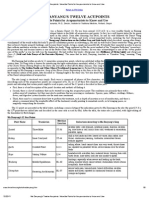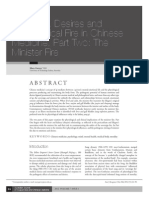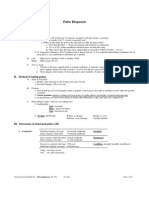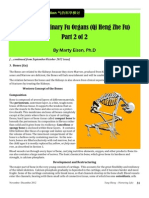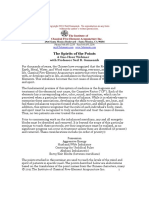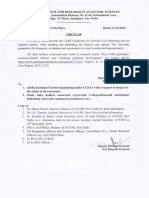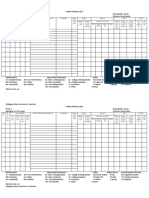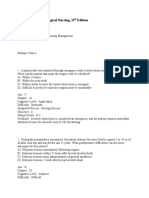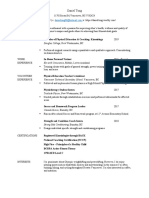EATMS - Discussion On Phlegm Damp Water
EATMS - Discussion On Phlegm Damp Water
Uploaded by
fernabarbCopyright:
Available Formats
EATMS - Discussion On Phlegm Damp Water
EATMS - Discussion On Phlegm Damp Water
Uploaded by
fernabarbOriginal Title
Copyright
Available Formats
Share this document
Did you find this document useful?
Is this content inappropriate?
Copyright:
Available Formats
EATMS - Discussion On Phlegm Damp Water
EATMS - Discussion On Phlegm Damp Water
Uploaded by
fernabarbCopyright:
Available Formats
Discussion on Phlegm, Damp and Water Retentions
Hui Jun Shen
Senior Lecturer of Acupuncture Programme University of Lincoln, UK
Phlegm ( , Tan ), damp ( , Shi) and water ( , Shui) retentions are three syndrome patterns of body fluids retention in TCM. The occurrence of these body fluids retentions is due to the abnormality of body fluid metabolism and distribution, mainly involves the dysfunction of three Zang Organs in the human body: Lung, Spleen and Kidney (Maciocia G, 2005). These retentions syndromes can be caused by various deficient or excessive pathogenic factors. However, once they are formed, phlegm, damp and water themselves belong to excess patterns. 1. Ancient Literature Review on Body Fluid Metabolism: Huang Di Nei Jing, or Yellow E Medicine, records the very first discussions about body fluid drinks are taken into Stomach, and then their essence will be transported into Spleen. Spleen transforms and scatters the (food) essence, and ascends the essence to Lung. Lung disperses and descends water through its pathways and surplus body fluid is 1, the predominant role of Kidney in body fluid metabolism is emphasised: Kidney dominates water (metabolism). (Huang Di, 200BC?) Therefore, the cooperative functions of three Zang organs, Lung Spleen and Kidney, are the key mechanism for body fluid metabolism and distribution. The dysfunction of any of these three organs could give rise to body fluid retention- phlegm, damp or water. Jin Gui Yao Lue (Golden Chamber of Synopsis) by Zhang Zhong Jing in East Han Dynasty (approx 200-219 DC) is the first book to discuss the clinical manifestations, differentiation and treatment of these three retentions. The discussions are scattered in three separate chapters, named Shui Qi (water Qi, or edema), Shi (damp) and Tan Yin (phlegm-fluids). Dr Zhang did not give much detail discussion on Shui Qi, and he only discussed damp from exogenous source invading meridians. However, he did discuss Tan Yin in great depth and divided Tan Yin into four types (Zhang Zhong Jing, 200-219DC?). In the long history of TCM, the later generations further developed Dr n these three retentions and established new concept of body fluid retention which is still used in nowadays clinical practice. 2. Body Fluid Retention: Aetiology and Pathogenesis Phlegm Phlegm is an endogenous pathogenic product, formed interiorly due to dysfunction of zang-fu organs or meridians, although such dysfunction can be triggered by exogenous wind invasion. Once phlegm is formed, it can in turn cause further pathological damage and give rise to various symptoms and/or illnesses (Liu Y, 1998). In this sense, phlegm is mutually pathological consequence as well as etiological cause.
Ancient TCM literature classify phlegm syndrome into substantial phlegm and non-substantial phlegm (Liu Y, 1998). Most cases of phlegm syndrome are of substantial phlegm in respiratory patients with lung dysfunction in dispersing and descending (D&D) body fluids as a key etiological and pathogenic role, and the location of phlegm retention is mainly in Upper Jiao. However, phlegm retention can be located in other body parts such as in heart, head, meridians, joint and under the skin, giving rise to some very different illnesses. In such cases there is no actual phlegm liquid (sputum) that can be classification does cysts and subcutaneous nodules. Therefore a better classification Respiratory phlegm is the phlegm as excretion of the lungs and bronchial tubes, ie sputum. This phlegm is the same concept as the phlegm or sputum in western medicine. Non-respiratory phlegm is the phlegm located in elsewhere of the body rather than respiratory system. This is a unique form of phlegm only recognised in TCM. See details in Table 1. In terms of the formation phlegm, there is a TCM saying as
the importance of Spleen in the formation of phlegm, it has also misled TCM professionals for many centuries to the ignorance on the important role of Lung in the phlegm formation, especially for the respiratory phlegm. Lung has dispersing and descending (D&D) function to work not only on the distribution of Qi, but also on the distribution of body fluids (Maciocia G, 2005). Any reasons causing Lung dysfunction in D&D can affect the normal distribution of body fluids to the body surface and descend of body fluids to Kidney/Bladder. With the dysfunction of Lung in D&D on Qi distribution and breathing, the body fluids will inevitably accumulate in Lung itself and cause further respiratory symptoms. Therefore, Lung dysfunction in D&D is as important as Spleen dysfunction in T&T (transformation and transportation) in the formation of phlegm, and even more important in case of respiratory phlegm. For other factors that cause phlegm, see Table 1. Damp Damp is also an abnormal retention of body fluids, which affects the physical functions of organs (most commonly spleen) and metabolism that can further cause other symptoms or illnesses (Liu Y, 1998). Therefore, similar with phlegm, damp also has a dual role in TCM etiology and pathogenesis. Damp can accumulates in our body via both exogenous and endogenous pathways. Exogenous damp can invade the body due to damp climate/weather and living in a damp environment etc. Endogenous damp is often caused by dietary or emotional and other factors impairing the transformation and transportation (T&T) functions of Spleen. The concept of exogenous damp and
Table 1: Outline of Phlegm Syndrome
Outline of Phlegm Syndrome Phlegm: its dual roles in TCM etiology and pathology Formation of phlegm 1. 2. 3. 4. 5. 1. 2.
Both a pathological condition and an aetiological factor. Dysfunctions of body fluids metabolism/ distribution create phlegm as a pathological product, And then phlegm goes on as a pathogenic factor to create other illnesses. Spleen deficiency: failing in T&T of body fluids, damp retention transforming into phlegm; Lung dysfunction: failing in D&D of body fluids, body fluids retention in lung itself. (Shen, 2009) Obstruction of meridians: body fluids failing to circulate but accumulating in certain location Heat: boiling body fluids to form phlegm Cold: condensing body fluids into phlegm Substantial phlegm phlegm in Lung (sputum): cough with profuse sputum. Non-substantial phlegm phlegm w joints, etc. in Middle Jiao- abdominal distension, nausea misting heart- coma, loss of consciousness, delirium, mania under skin- cysts, lumps of non-blood stasis type in channels/joints- numbness in limbs, swelling and deformation of joints misting orifice of brain- epilepsy, wind-stroke.
Classification of phlegm
A better classification: Respiratory Phlegm Non-Respiratory Phlegm Clinic syndrome patterns 1. 2. 3. 4. 5. (Damp) Phlegm: respiratory or non-respiratory Cold Phlegm: respiratory or non-respiratory Heat Phlegm: respiratory or non-respiratory Dry Phlegm: respiratory phlegm only Wind Phlegm: non-respiratory phlegm only in channels- tremor misting orifice of brain- epilepsy, wind-stroke
endogenous damp is commonly used in understanding of damp etiology. When coming to treatment, same or similar herbal medicines or acupuncture points are used to drain damp from the body, no matter exogenous or endogenous. Spleen dysfunction (mostly Spleen deficiency) in T&T for body fluids gives rise to damp retention. Once damp is accumulated in
the body interior for any reasons, Spleen is the most susceptible organ to be impaired by damp. The location of damp retention is mainly in Middle Jiao, but can be in joints/meridians, etc (Maciocia G, 2005).
Exogenous Damp: fluids? Damp environment, damp weather, etc. Damp accumulating in Middle Jiao Endogenous damp: Cold food/ unhealthy diet
The clinical classification, or further differentiation, of damp retention syndrome is largely based on damp being associated with other pathogenic factors and the location of damp retention. By looking at other pathogenic factors accompanying with damp, there are damp (alone), wind damp, cold damp, damp heat and damp phlegm syndromes. By location, wind damp often invades or accumulates in exterior or meridians causing headache
Spleen Dysfunction
/migraine or Bi syndrome of wind damp pattern; cold damp can invade or accumulate in both meridians or internal Zang-Fu organs; damp heat tends to invade or accumulate in Zang-Fu organs much more often; Damp phlegm can be in Upper Jiao (respiratory phlegm), Middle Jiao or in meirdians. Dam heat Table 2: Classification of damp retention Associating with other pathogenic factors In exterior Wind damp Wind damp Exogenous In meridians Cold damp Damp phlegm Endogenous In internal zangfu organs* Damp phlegm Cold damp Damp heat
syndrome can be further classified by the location as damp heat in Middle Jiao (Spleen & Stomach), damp heat in intestines, damp heat in Liver/Gallbladder, damp heat in bladder, and damp heat in Lower Jiao. See details in Table 2.
Etiology
Location
Clinical patterns Wind damp exterior syndrome Headache/migraine, Bi syndrome Bi syndrome Local retention causing swelling, heaviness, etc In upper Jiao (respiratory phlegm), in middle Jiao Cold damp in middle Jiao, in intestines, in lower Jiao In middle Jiao, in Liver/gallbladder, in interstines, in bladder, in lower Jiao, in blood (systemic damp heat)
*: internal damp can be caused through either exogenous or endogenous route. Water Water retention causes edema. This is also due to the abnormality of body fluids metabolism and distribution in our body, which is primarily dominated by Kidney. Water retention is purely due to endogenous pathogenic reasons, although in some cases, such interior pathogenic changes can be triggered out by exogenous wind invasion. As a pathogenic consequence, water retention is the outcome of zang-fu dysfunctions and predominantly due to Kidney deficiency, although dysfunction of Spleen in T&T and Lung in D&D also can cause water retention. Once formed, it does not cause any further impairment to the zang-fu organs and meridians, etc. So in this sense edema or water retention is not an etiological factor. The principal location for water retention is Lower Jiao. 3. Biomedical Understanding on Three Retentions: Body fluid retention also exists in western medicine. Although western medicine and TCM are so different in term of understanding the physiological functions and pathological changes of the body, the subject they look into is actually the same: abnormality of body fluid metabolism. While most of the time it is almost impossible to use biomedical knowledge to explain the theory of TCM, a very unique and exclusive similarity between the two medical systems can be disclosed in the understanding of body fluid retention. Water retention (oedema): this is basically the same concept in the two medical systems. The body fluid accumulates in the space outside of body cells or between body cells; therefore we can give it a name as inter-cellular retention. In western medicine it is called extra-cellular edema. The functions of body cells are not directly affected; therefore edema usually does not cause other symptoms or other disorders. Damp retention: not recognised in western medicine. However, this is immensely likely as intre-cellular retention, the fuild retention inside the body cells. As the result, the interior environment and functions of body cells are affected, causing dysfunction in cellular metabolism, especially the energy metabolism of cells, giving rise to various symptoms, mostly as Qi deficiency like symptoms. Many studies show that in damp syndrome patients, certain cellular metabolic enzymes become abnormal in quantity or activity ( , et al. 2001). This also gives evidence that damp syndrome is more related to cellular metabolism. Further researches should be performed to further explore this hypothesis. Phlegm retention: Both medical systems share the same concept on respiratory phlegm, or sputum, which is a sticky mucus fluid produced in the respiratory truct. However, phlegm has a wider meaning in TCM, which include various localised fluid rention in other parts of the body, or non-respiratory phlegm as discussed above. In terms of western medicine, both respiratory and non-respiratory phlegms are localised fluid term which means all body cavities, including pathological cysts. ms to the definition of third space retention. Non-respiratory phlegm syndrome is also the phlegm retention in the third space. Hydrothorax (fluid retention in pleural cavity) and ascites (fluid retention in peritoneal cavity) were classified into phlegm syndrome as early as in Golden Chamber of Synopsis (Zhang Zhong Jing, 200-219DC?). Other two good examples of nonthe accumulation of lymphatic fluid in the inner ear tube causing pressure to the vestibulocochlear nerve and disturbing its function of maintaining body balance. PCOS is pathological fluid accumulation and formation of multiple cysts in the ovary which as an occupant disorder affects the normal structure and therefore the function of the ovary itself. These two conditions are totally irrelevant in western medicine. However, they have a same nature as fluid retention in a third space. In TCM, we believe they are both phlegm (non-respiratory phlegm) retention and we treat these conditions by using phlegm resolving herbs.
4. Summery of three retentions (Table 3) Phlegm Damp Water Retention Retention Retention Retention of body fluids Due to abnormality of body fluids metabolism/distribution Mainly involve dysfunction of Lung, Spleen and Kidney Excess syndrome. Endogenous Endogenous Endogenous Exogenous Lung Upper Jiao Both pathological product & aetiological factor Spleen Middle Jiao Both pathological product & aetiological factor Intre-cellular retention Kidney Lower Jiao Purely pathological product
What in common
Aetiology Main involved organ
Main location Pathological role
Biomedical understanding References: Huang Di?, etc ( Medicine
Inter-cellular retention
Liu. Y (1998) Fundamental Theories of Traditional Chinese Medicine, Beijing: Academy Press Maciocia G (2005) The Foundations of Chinese Medicine(Second Edition). Edinburgh: Churchill Livingstone.
Shen, H (2009) Syndrome Differentiation: No More Confusions. ATCM Seminar Note 1st November 2009 Zhang Zhong Jing (200-219DC?) Golden Chamber of Synopsis na+-k+-atpase 2001 33(10) 30. . dbhase j .
You might also like
- Iso 41001Document2 pagesIso 41001Sine0% (1)
- Wu Yun Liu Qi: 5 Energies & 6 QiDocument2 pagesWu Yun Liu Qi: 5 Energies & 6 QiAnon100% (1)
- SHANG HAN LUN Overview PDFDocument3 pagesSHANG HAN LUN Overview PDFBobNo ratings yet
- Lin Syndrome PDFDocument2 pagesLin Syndrome PDFdavidninrio67% (3)
- Wen Bing2Document9 pagesWen Bing2Jaffer Aftab0% (1)
- Ba Guan: The use of Cupping in the traditional Chinese medicine (TCM)From EverandBa Guan: The use of Cupping in the traditional Chinese medicine (TCM)Rating: 5 out of 5 stars5/5 (1)
- 王居易 The Clinical Significance of Palpable Channel Changes PDFDocument7 pages王居易 The Clinical Significance of Palpable Channel Changes PDFJose Gregorio Parra100% (1)
- 1 LIVGBIntro OverviewDocument28 pages1 LIVGBIntro Overviewapi-3719759100% (1)
- Ma Danyang's Twelve Acupoints Valuable Points For Acupuncturists To Know and UseDocument8 pagesMa Danyang's Twelve Acupoints Valuable Points For Acupuncturists To Know and Usepar_avion100% (1)
- New Patient Intake FormDocument6 pagesNew Patient Intake FormCraig TrujilloNo ratings yet
- COVID-19 Patient: Allied Hospital Lab, FaisalabadDocument2 pagesCOVID-19 Patient: Allied Hospital Lab, FaisalabadTurkey DramasNo ratings yet
- 05 Brechtje SebregtsDocument6 pages05 Brechtje Sebregtstigerstyle1No ratings yet
- Identification of Patterns According To The Eight PrinciplesDocument102 pagesIdentification of Patterns According To The Eight PrinciplesAnonymous 5IUoLwGSd100% (1)
- Hammer PDFDocument12 pagesHammer PDFDidik HariadiNo ratings yet
- Z'ev Rosenberg InterviewDocument7 pagesZ'ev Rosenberg InterviewZ'ev Rosenberg100% (1)
- The Ying Qi Cycle and The Diurnal Evolutionary Unfoldment of The Extraordinary VesselsDocument6 pagesThe Ying Qi Cycle and The Diurnal Evolutionary Unfoldment of The Extraordinary Vesselsrazvan rotaru100% (1)
- AJACM 2012 7 1 Emotions & Desires Part Two - M GarveyDocument7 pagesAJACM 2012 7 1 Emotions & Desires Part Two - M GarveyRicardo TeixeiraNo ratings yet
- Chinese Herbal Dose in Ancient and Modern Times: A Comparative StudyDocument4 pagesChinese Herbal Dose in Ancient and Modern Times: A Comparative StudyNguyễn TiếnNo ratings yet
- RReviews2011 PDFDocument121 pagesRReviews2011 PDFtomas100% (1)
- 60-27 Diabetes MellitusDocument10 pages60-27 Diabetes MellitusGabriel Navarro100% (1)
- 2-3 Hara Diagnosis 02102013 PDFDocument14 pages2-3 Hara Diagnosis 02102013 PDFHendrawan Pratama100% (1)
- Psychosomatic Copy 2-Barcelona PDFDocument72 pagesPsychosomatic Copy 2-Barcelona PDFgigicarvajalNo ratings yet
- Seidman 3yin3yang1 PDFDocument24 pagesSeidman 3yin3yang1 PDFelmraksi30100% (1)
- Pediatric Class Hand Out 2008Document33 pagesPediatric Class Hand Out 2008Ramesh Babu ManivannanNo ratings yet
- Spleen (Chinese Medicine)Document2 pagesSpleen (Chinese Medicine)Doktormin106No ratings yet
- 7 Shang Han DoctrineDocument50 pages7 Shang Han Doctrinepanisaj100% (2)
- Pulse DiagnosisDocument4 pagesPulse Diagnosisrashax100% (1)
- Pediatrics Jake FratkinDocument18 pagesPediatrics Jake Fratkinshurino1100% (1)
- Fundamental Substances Qi, Blood, FluidsDocument62 pagesFundamental Substances Qi, Blood, FluidsLunaLureNo ratings yet
- Yin FireDocument4 pagesYin FireezraallenNo ratings yet
- The Extraordinary Fu Organs Yang-Sheng 2012-06 PDFDocument5 pagesThe Extraordinary Fu Organs Yang-Sheng 2012-06 PDFBudo Media100% (1)
- Understand TCM Classic Formula by Case StudiesDocument84 pagesUnderstand TCM Classic Formula by Case StudiesDE100% (2)
- Large Intestine Pattern Differentiation in Chinese MedicineDocument6 pagesLarge Intestine Pattern Differentiation in Chinese MedicineFinderlucian Lucian100% (1)
- Diagnostico Chines (Inglês)Document40 pagesDiagnostico Chines (Inglês)Sónia Oliveira100% (1)
- 6 Timelines of TCM FormulasDocument5 pages6 Timelines of TCM Formulaseran76No ratings yet
- Course C Basic Theories of Acupuncture and MoxibustionDocument36 pagesCourse C Basic Theories of Acupuncture and MoxibustionGermey HoongNo ratings yet
- Web - The Eight Principles of Diagnosis in Traditional Chinese MedicineDocument8 pagesWeb - The Eight Principles of Diagnosis in Traditional Chinese MedicineJing CruzNo ratings yet
- Geriatrics in Chinese MedicineDocument3 pagesGeriatrics in Chinese MedicineMaja Mudri100% (1)
- 1996 Root and Branch Clinical ApplicationsDocument9 pages1996 Root and Branch Clinical Applicationsdoktormin106No ratings yet
- Huang Di Nei Jing Week 3Document3 pagesHuang Di Nei Jing Week 3Emma KerriganNo ratings yet
- The Kidney and Heart in CM - Part 2Document7 pagesThe Kidney and Heart in CM - Part 2davidg2012No ratings yet
- Shang Han Lun OverviewDocument3 pagesShang Han Lun OverviewPedro Maia80% (5)
- Jing Bie Divergent Channels SampleDocument12 pagesJing Bie Divergent Channels SampleRudolph Antony ThomasNo ratings yet
- Under The Tongue Diagnosis 2009Document24 pagesUnder The Tongue Diagnosis 2009InfohoggNo ratings yet
- Yuan Source PoiDocument49 pagesYuan Source PoiSAM100% (1)
- Ma DanyangDocument9 pagesMa DanyangKeefer Michael100% (4)
- The Eightextraordinary VesselsDocument9 pagesThe Eightextraordinary Vesselsrubenildo_coutinhoNo ratings yet
- Dui Yao For CH 7 Descend Stomach Rebellious Qi PDFDocument5 pagesDui Yao For CH 7 Descend Stomach Rebellious Qi PDFbateriameaNo ratings yet
- Treating An Earth "Causative Factor" Patient UsingDocument7 pagesTreating An Earth "Causative Factor" Patient UsingpacdoxNo ratings yet
- Spirits of The Points20110823 - Neil - Gumenick - Webinar+1-Hr+notesDocument3 pagesSpirits of The Points20110823 - Neil - Gumenick - Webinar+1-Hr+noteshihi12No ratings yet
- Sun Simiao and Dietetics FinalDocument7 pagesSun Simiao and Dietetics Finalgaetanscribd100% (2)
- Tongue Gallery: Example 1 - NEWDocument13 pagesTongue Gallery: Example 1 - NEWtoanbauNo ratings yet
- Dr. Fengs clinical application of the Nine Palaces Acupuncture 九宫针法 finish PDFDocument6 pagesDr. Fengs clinical application of the Nine Palaces Acupuncture 九宫针法 finish PDFJose Gregorio Parra100% (2)
- 4LIVfunctions ElizabethDocument23 pages4LIVfunctions ElizabethLunaLure100% (2)
- The Differences Between TCM and CCMDocument2 pagesThe Differences Between TCM and CCMlaukuneNo ratings yet
- Manaka HammerDocument2 pagesManaka Hammerjhonny100% (3)
- Qualities of A Great AcupuncturistDocument6 pagesQualities of A Great AcupuncturistKim HaslamNo ratings yet
- TCM VitaminsDocument4 pagesTCM Vitaminskeiraku100% (3)
- Lesson: Dr. Leon Hammer, M.DDocument8 pagesLesson: Dr. Leon Hammer, M.DRocío JMNo ratings yet
- Jing Fang Formula Families-Basic Course StructureDocument2 pagesJing Fang Formula Families-Basic Course StructureJonasWinther67% (3)
- Tongue Diagnosis of Traditional Chinese Medicine For Rheumatoid ArthritisDocument19 pagesTongue Diagnosis of Traditional Chinese Medicine For Rheumatoid Arthritisluyawin100% (2)
- Acupuncture: A Comprehensive Guide to the Practice and BenefitsFrom EverandAcupuncture: A Comprehensive Guide to the Practice and BenefitsNo ratings yet
- Suggested Grade 9 Test Questions: Chemical Hazards: Teacher's GuideDocument3 pagesSuggested Grade 9 Test Questions: Chemical Hazards: Teacher's GuideKatelyn TaylorNo ratings yet
- CARE Guidelines For Case ReportingDocument7 pagesCARE Guidelines For Case ReportingPriyanka SharmaNo ratings yet
- CPBRD A Results-Based Assessment of Bayanihan To Heal As One ActDocument69 pagesCPBRD A Results-Based Assessment of Bayanihan To Heal As One ActBab SitaNo ratings yet
- Family Profile 2023 BlankDocument28 pagesFamily Profile 2023 BlankReveinne Kate LuisNo ratings yet
- HIVDocument3 pagesHIVintanpalupiNo ratings yet
- BurnoutDocument10 pagesBurnoutKhyara Marie Estante DemiarNo ratings yet
- Jurnal Diabetes MelitusDocument7 pagesJurnal Diabetes MelitusNova RosalinaNo ratings yet
- Peritoneal DialysisDocument56 pagesPeritoneal DialysisVanet100% (2)
- Chapter 18 - Preoperative Nursing ManagementDocument14 pagesChapter 18 - Preoperative Nursing ManagementEmily CormierNo ratings yet
- Spikes PDFDocument11 pagesSpikes PDFMatsrialNo ratings yet
- B Inggris Widya Tirta DewiDocument4 pagesB Inggris Widya Tirta Dewiwidya tirtaNo ratings yet
- Regresi OrdinalDocument16 pagesRegresi OrdinalYos OsingmahiNo ratings yet
- Proctology Brochure - 1Document12 pagesProctology Brochure - 1Avinash ReddyNo ratings yet
- Pil 4336Document5 pagesPil 4336KoustuvGaraiNo ratings yet
- Vital Signs TakingDocument5 pagesVital Signs TakingJohnNo ratings yet
- Hemochromatosis Group 4Document11 pagesHemochromatosis Group 4kristine caminNo ratings yet
- Practical Research 2 Module 3Document9 pagesPractical Research 2 Module 3Ericka Marie AlmadoNo ratings yet
- Final Dessertation ReportDocument33 pagesFinal Dessertation ReportDeep ChoudharyNo ratings yet
- SWOT Analysis 2024Document2 pagesSWOT Analysis 2024ginoballano30No ratings yet
- Daniel Tong Resume 2021Document1 pageDaniel Tong Resume 2021api-336510768No ratings yet
- MDR ChecklistDocument6 pagesMDR ChecklistGretchen UptonNo ratings yet
- MD Iqbal's LP DraftDocument13 pagesMD Iqbal's LP DraftJoe (joe)No ratings yet
- Lecture16 Risk Estimate PDFDocument75 pagesLecture16 Risk Estimate PDFandikaprasdiptaNo ratings yet
- National Aids Control ProgrammeDocument12 pagesNational Aids Control ProgrammeNur Adilla MahmudNo ratings yet
- RRLDocument10 pagesRRLKimm TolledoNo ratings yet
- CUDA APP 1000 Jet Spray Wash Detergent 12-5-16 MSDS PDFDocument5 pagesCUDA APP 1000 Jet Spray Wash Detergent 12-5-16 MSDS PDFYoutube For EducationNo ratings yet
- eBookSubjectSet MentalHealthDocument3 pageseBookSubjectSet MentalHealthkitianahelloNo ratings yet








